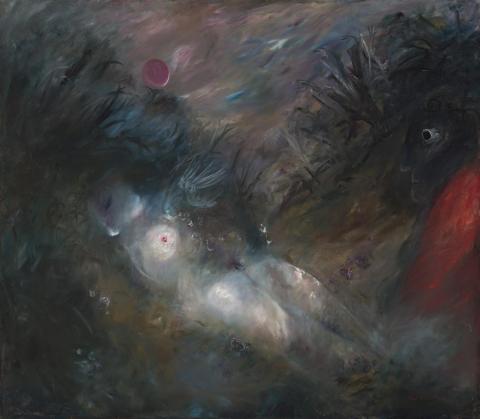SLEEPING NUDE, 1962
ARTHUR BOYD
oil and tempera on composition board
160.0 x 183.0 cm
signed lower right: Arthur Boyd
Collection of Michael Wells and Susannah York, London
Savill Galleries, Sydney
Private collection, Melbourne, acquired June 1998
Arthur Boyd: Retrospective Exhibition, Whitechapel Gallery, London, June–July 1962, cat. 146 (cat. no. inscribed verso, lent by the artist)
Arthur Boyd Retrospective Exhibition, National Gallery of South Australia, Adelaide, March 1964, cat. 52 (label attached verso, lent by Mrs Michael Wells, London)
Arthur Boyd Retrospective Exhibition of Paintings,1936–62, Museum of Modern Art and Design, Melbourne, 5–28 May 1964, cat. 56
Three Australian Painters, Towner Gallery, Eastbourne, 1965
A Century of Australian Painting, 1888-1988, Savill Galleries, Sydney, 21 April – 21 May 1988, cat. 45
Arthur Boyd: Retrospective Exhibition June–July 1962, The Gallery, London, 1962, p. 30, cat. 146
Philipp, F., Arthur Boyd, Thames and Hudson, London, 1967, pp. 108–110, 127–128, cat. 10.70, pl. XXXIX (illus.)
McKenzie, J., Arthur Boyd: Art and Life, Thames and Hudson, London, 2000, pp. 109–111
Arthur Boyd's Sleeping Nude, 1962 is a brilliant work in a stellar oeuvre abundant with riches. Its lineage can be traced back to the Bride Series, especially in the figuration of the white associated with the wedding dress and the red soldier's jacket of the profiled, voyeuristic, black bridegroom at her feet, fixated of form and eye. Its varied, London antecedents include Bridegroom in a Black Creek, 1960, once in the collection of Sidney Nolan, and the spectacular Figure in a Landscape (Nude Washing in a Creek III), 1961 in the Art Gallery of New South Wales, Sydney. The Boyd scholar Franz Philipp thought so highly of Sleeping Nude, 1962 that he devoted several pages of comment and a colour plate to it. Waxing lyrical, 'In the Sleeping Nude, [he wrote] the dark, obsessional side of Boyd's myth of Eros, if not altogether absent, is subdued - an undertone only ...'1 Classifying it among 'the 'Venus observed' images', he compared Boyd's approach within the context of some of the greatest paintings of nudes in Western art by the great Venetians Giorgione and Titian through to the more modern, Edouard Manet's Olympia. He hailed Boyd's painting as 'the dénouement of the mythical cycle, ... the most tranquil and poetic picture of this phase of great creative abundance ...'2
The loved one is embraced by the landscape and sleep of the subconscious, suggestively conveyed through the sensuous application and movement of paint. Light flickering across the chaste though inviting body hints of cool flames of passion. Through this blending of the elegant and the erotic Boyd explores and equates ethereal love and carnal desire. His harmonious fusion of figures and landscape, of the primal watched over by a purple moon, creates a highly individual icon of Eden. A devotional undercurrent adds to the richness of its complexity. Janet McKenzie, while acknowledging that Sleeping Nude, 1962 is derived from the 'classical images of Venus,' engagingly argues that 'it has been completely reinvented in a contemporary manner. No longer representing an image of ideal beauty, Boyd's nudes can be interpreted as perceptive images of twentieth-century woman.'3 She continues with an illuminating exploration of the painting's autobiographical side.
Sleeping Nude, 1962 was included in Boyd's major retrospective of 1962 at London's Whitechapel Gallery. The exhibition received reviews numerous and enthusiastic in The Times, The Tatler, Guardian, Daily Telegraph and others. Nude with Beast III, 1962, also in the exhibition, entered the National Gallery of Victoria in 1966 as another of the treasures courtesy of the Felton Bequest.
1. Philipp, F., Arthur Boyd, Thames and Hudson, London, 1967, p. 110
2. Ibid, p. 108
3. McKenzie, J., Arthur Boyd: Art and Life, Thames and Hudson, London, 2000, p. 109
DAVID THOMAS
